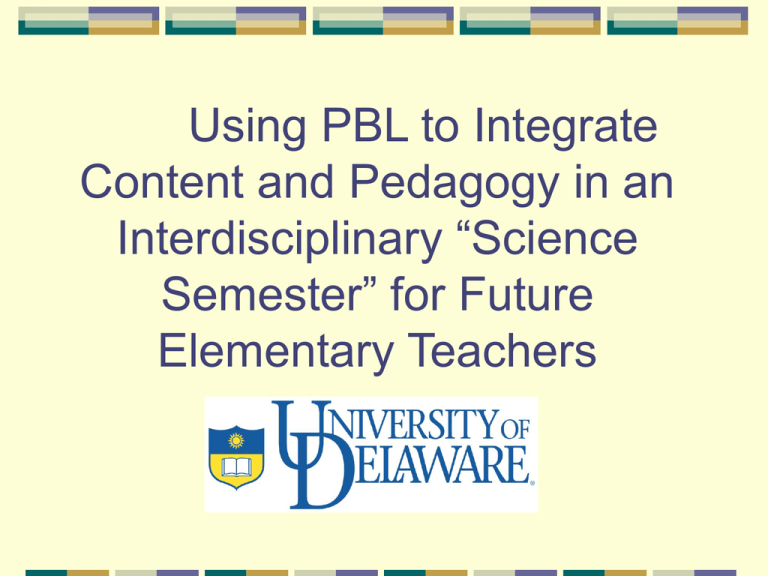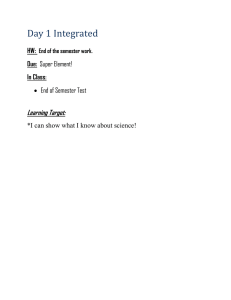Using PBL to Integrate Content and Pedagogy in an Interdisciplinary “Science
advertisement

Using PBL to Integrate Content and Pedagogy in an Interdisciplinary “Science Semester” for Future Elementary Teachers National Research Council (2001) Educating Teachers of Science, Mathematics, and Technology Science...departments should assume greater responsibility for offering college-level courses that provide teachers with strong exposure to appropriate content and that model the kinds of pedagogical approaches appropriate for teaching that content. [C]olleges and universities should reexamine and redesign introductory college-level courses in science and mathematics to better accommodate the needs of practicing and future teachers. What would such a course be? Inquiry-based Multidisciplinary Instructors would model instruction Student collaboration Science Semester: A Multidisciplinary Collaboration Biological Sciences Geology Astronomy & Physics School of Education Education Research and Development Center Mathematics & Science Education Resource Center Structure of the Science Semester Richard Donham, Mathematics & Science Education Resource Center Earth Science 4 Credits Life Science 4 Credits Science Semester 15 Credits Physical Science 4 Credits Science Education Methods 3 Credits Sciences: Five 2-hr meetings/wk Methods: Two 1½ hr meetings/wk Science Science Semester Semester Earth, life and physical science laboratories each week (6 hr) Science Semester Goal: to foster future teacher’s understandings of science, teaching and learning and to support use of inquiry in their own classrooms Science Semester Structure Four PBL problems Group & Individual products Mixed instructional methods Science Semester: Instructor Responsibilities Lead one of the investigations Participate & collaborate on other investigations Attend all class meetings The PBL Investigations Deborah Allen Department of Biological Sciences Conflicting Practices in Science Education K-12 reform Standards-based content & skills Inquiry Integrates disciplines Higher education Textbook- & lecturedriven content & skills Transmission Separates disciplines Characteristics of Ideal PBL Investigations Complex enough for interdisciplinary themes Engaging and motivational from student perspective Allow for college-level exploration of big ideas that connect to K-6 science education standards Allow for products that flow naturally Allow for gradual introduction and building of PBL skills Can be integrated with lectures, active learning activities, and whole class discussions Overview of the Four Unit Investigations Problem Scenarios Interdisciplinary content themes Products Labs and special activities Unit One - Physical Science: What is Energy? Scenario: Students assume roles of 8th grade teachers. They apply to and attend a summer curriculum development institute sponsored by NREL. They learn about energy as they fill out an extensive application for the institute, then attend initial sessions. Unit One (cont). Products: Informal presentation on energy-related topic Report on standards-based curriculum themes related to energy Content themes: Sources of energy, electricity, environmental consequences of energy use, flow of energy through the biosphere, energy in chemical reactions, global carbon cycle Unit Two - Biology: Kids, Chemicals & Cancer Scenario: A child in Tom’s River, NJ develops leukemia. Citizens in the town begin to notice what seems to be a high incidence of childhood cancers. They think they have a “cancer cluster,” and suspect that a local chemical manufacturing plant and an illegal toxic waste dump are to blame. Parents of the child about whom the problem is written Unit Two (cont). Products: Report on chain of evidence and inference necessary to establish a cancer cluster; peer review of 1st draft In the role of a teacher in whose class there is a child with cancer, design classroom activities that address children’s questions about cancer Unit Two (cont) Supporting Labs DNA extraction and structural models Effects of tobacco on mutation in bacteria Cluster Busters – computer-based investigation Content themes: Structure & function of DNA; cell cycle; causes, effects, & treatment of cancer; cancer clusters; environmental health; organic chemistry; soils; ground water; hydrologic cycle Unit Three - Elementary Science Education: Did my students learn what they’re supposed to? Scenario: Students explore and evaluate a science curriculum kit. They write an extensive report on their evaluation, teach an activity from the kit (with their peers as students), and present a poster to the university and local science education community. Unit Three (cont) Content Themes: • Aligning standards, curriculum & assessment in instruction • Pedagogical content knowledge Unit Four – Earth Science: Limulus polyphemus! Scenario: Students grapple with the complex issues surrounding an ongoing, heated controversy about establishment of the annual catch limit for the horseshoe crab, an environmentally and economically important organism in the Delaware Bay. Unit Four (cont) Products: Presentation on horseshoe crab biology, role in Bay ecosystem, and economic importance Analysis of evidence from public testimony on the issues – conclude with a recommendation based on the best evidence Unit Four (cont) Content themes: Life cycles & niches of horseshoe crab and other Bay organisms; seasons; phases of the moon; tides; coastal geology; water chemistry; technology & science Remaining Questions/Issues Instructor interpretations of PBL are not the same – can students make sense of our differing perspectives in a way that will be useful to their future teaching? If initial investigations are more structured by instructor, will students graciously allow the instructor presence to “fade away?” Will “message” be lost with subsequent courses, particularly if they are science courses? Teaching Education in the Science Semester: Benefits & Challenges Danielle Ford School of Education Issues with integrating education Does the Science Semester meet the needs and goals of the elementary teacher education program? Can we achieve a successful integration of education into a discipline-dominated semester? The Education Course in the Science Semester Elementary Curriculum: Science (EDUC 341) Introduction to teaching science in the elementary school. Includes the study of current elementary school programs, instructional materials, teaching strategies, lesson planning and implementation and the appraisal of pupil achievement. Practicum included. Goals for EDUC 341 Develop an understanding of the nature of science Gain familiarity with current research on children’s learning of science and their conceptions of science content Explore the concepts of community, identity, diversity, equity and relevance Goals for EDUC 341 Become familiar with the current theoreticallybased practices in science instruction, including inquiry instruction, alternative assessment Gain experience in planning, conducting, and analyzing science instruction Become familiar with the tools used in science instruction, including science curricula, science talk, science texts and technology, people, and places Challenges in the Traditional Version of EDUC 341 Uneven science content prior to curriculum course 6 concurrent education courses to compete with ETE culture Science Semester Benefits Model of content Shows students what integrated science curriculum looks like Provides specific content examples, can be coordinated precisely with education theory and pedagogy Model of pedagogy – PBL and other science teaching strategies – “practicing what we preach” Science Semester Concerns Would education issues be lost in the emphasis on science content? Meta level understanding of pedagogical models too conceptually challenging for sophomores? Conflicting pedagogical models across faculty? What actually happened Students were clearly focused on education, wanted more Content concurrent with education course sometimes worked, but sometimes didn’t Capitalized on differences in pedagogy to explore multiple models of instruction Remaining Questions/Issues Supporting learners post-science semester Field experiences Sustainability Project Evaluation & Research Steve Fifield Education Research & Development Center Questions Research methods How do students’ science & pedagogical understandings develop in response to this PBL-based experience? How do students make sense of unfamiliar approaches to learning & teaching? Content assessments Coursework Student writing Interviews Classroom observations Surveys Student writing Interviews Preliminary Findings Science content & pedagogical knowledge Science Semester impacts students’ views of: Knowledge sources Knowledge contexts & connections Learning processes & products Preliminary Findings Responses to unfamiliar approaches to learning & teaching Science Semester challenges students’: beliefs about the roles & responsibilities of teachers & learners criteria for knowing & learning self-understandings as learners & future teachers An Administrator’s Perspective George Watson Associate Dean, College of Arts and Sciences Administrative support for innovative teaching Promoting interdisciplinarity within a discipline-based organization Achieving sustainability of innovative practices Striving for scalability from a pilot project Benefits accrued To the students To the faculty To the institution To the public



